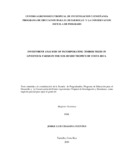Investment analysis of incorporating timber trees in livestock farms in the sub-humid tropics of Costa Rica

View/
Date
2004Author
Chagoya Fuentes, Jorge L.
Type
Tesis de maestría
Metadata
Show full item recordAlternative title
Análisis de inversión en la incorporación de árboles maderables en fincas ganaderas en el Trópico Sub-húmedo de Costa Rica
Description
Tesis (Mag.Sc.) - CATIE, Turrialba (Costa Rica), 2004
Abstract
Un análisis ex-ante de beneficio costo fue realizado con el objetivo de explorar la viabilidad financiera en la incorporación de árboles maderables bajo diferentes arreglos en fincas ganaderas de la zona Pacífico Central de Costa Rica. Los modelos fueron: 1) árboles maderables en cercas 2) árboles maderables bajo regeneración natural in pasturas naturales con terneros en engorde, 3) cambio de uso de suelo de pastura degradada a regeneración secundaria, 4) árboles maderables a perpetuidad en pasturas mejoradas con terneros en engorde. El componente forestal fue C. odorata L. Un pago por servicios ambientales (PSA) fue considerado. La inversión presentó alta sensibilidad a cambios en la tasa de descuento y en precio de la madera. Cuando el riesgo es aplicado al precio de la carne la inversión presenta un 37,5 por ciento y un 43.2 por ciento de probabilidades de éxito para VAN y VET, respectivamente. En todas las inversiones, el análisis del flujo de caja indicó un flujo neto negativo en los primeros años en comparación con el flujo de caja en la situación "sin el proyecto". El PSA contribuye a incrementar los indicadores financieros. Sin embargo, su contribución en el flujo de caja incremental fue marginal. An ex-ante benefit cost analysis was developed with the objective to explore the financial feasibility of incorporating timber trees under different arrangements in livestock farMON in the Central Pacific Region of Costa Rica. The models were: 1) timber trees in fences, 2) timber trees under natural regeneration in natural grassland with fattening livestock, 3) land use change from degraded grassland to secondary regeneration forest, and 4) timber trees in a perpetual silvopastoral system in improved grassland with fattening livestock. The timber component was C. odorata L. A payment for environmental services was considered. The investment showed high sensitivity to changes in discount rates and wood prices. When risk was applied to beef price, the investment showed a low likelihood of success (37.5 percent for NPV and 41.3 percent for LEV, respectively). For all investments, there was a negative net flow in the first years in comparison with the net cash flow in the situation without the project. PES contributed to improve the financial indicators. However, its contribution to the incremental flow was marginal.
Keywords
Asesor
Gobbi, J.
Publisher
CATIE, Turrialba (Costa Rica)
URI (Permanet link to cite or share this item)
https://repositorio.catie.ac.cr/handle/11554/5262Collections
- Tesis [3111]

